 Those following the developments in Iran may ask themselves why the Iran’s Supreme Leader, Ali Khamenei has openly expressed support for the current president, Mahmoud Ahamadinejad.
Those following the developments in Iran may ask themselves why the Iran’s Supreme Leader, Ali Khamenei has openly expressed support for the current president, Mahmoud Ahamadinejad.
He is surely aware of the fact that Ahmadinejad has by now become the most hated figure in the contemporary history. Yet, he has left no doubt that Ahmadinejad is his favored candidate for the June 12th presidential elections.
Ahmadinejad was born in 1956 in the town of Garmsar (Central province). In 2003 and 2004, in addition to being the mayor of Tehran, he was one of the members of a council coordinating the extremist factions loyal to the regime. With the knowledge that his secret council was in effect more powerful than the government itself in adopting sensitive system wide decision, Khamenei took note. The Supreme Leader soon realized that Ahmadinejad is decisive in pursuing fundamentalist policies and is loyal. Khamenei ordered the Islamic Revolutionary Guard Corps (IRGC) to use his office’s budget to build a large highway in Tehran, with the credit being given to Ahmadinejad. In doing so, he was touted as a powerful mayor and a noted political figure.
As Tehran’s mayor, Ahmadinejad:
- Built a memorial for a fundamentalist suicide bomber responsible for the attack against the American base in Beirut, which killed 241 US marines and 58 French paratroopers.
- Built a memorial for Khaled Islamboli, who assassinated former Egyptian president Anwar Sadat. Before becoming mayor, Ahmadinejad had done much for the regime. In the early 1980s, he participated in the torture imprisonment of university students. As a close associate of the infamous torturer Assadollah Lajevardi, he learned from and worked with one of the most ruthless torturers in the world.
 In subsequent years, and as the war with Iraq intensified, Ahmadinejad became a skilled member of the IRGC. He did not fight in the war front but was among the commanders of “extraterritorial operations,” a less disgraceful pseudonym for acts of terrorism duties of the IRGC outside of Iran.
In subsequent years, and as the war with Iraq intensified, Ahmadinejad became a skilled member of the IRGC. He did not fight in the war front but was among the commanders of “extraterritorial operations,” a less disgraceful pseudonym for acts of terrorism duties of the IRGC outside of Iran.
On the one hand, he conducted operations in various foreign cities such as Vienna, Paris, Istanbul, and also along the Iran-Iraq border. One such operation involved the assassination of Abdolrahman Ghassemlou, Secretary General of the Kurdish Democratic Party of Iran, in the Austrian capital. While in Tehran, he was involved in the assassination of Dr. Sami, the first post-revolution Health Minister.
Ahmadinejad has always been at the forefront of the regime’s extremism and terrorist operations. In the 1990s, he was among the main leaders of plain-clothed suppressive agents called the “Ansar-e Hezbollah” group. They are part of mullah’s unofficial suppressive organs. Among their duties is to attack student dormitories, organize violent counter-protests against peaceful students and workers. “Ansar-e Hezbollah” was Ahmadinejad’s stepping stone, propelling him to governorship of Lorestan, Ardebil provinces, and ultimately to Tehran mayorship. Irrespective of his official posts, Ahmadinejad retains his close ties with the group. His Thursday night speeches on Thursdays truly captivate his “Ansar” audience.
In the course of the July 2005 presidential race, no one inside or outside of the Iranian regime anticipated Ahmadinejad’s rise to presidency. Clearly, Khamenei had guaranteed Ahmadinejad’s victory with significant influence from the IRGC. This collaborative operation was codenamed “Quiet Light,” referring to unknown wartime operations which typically remained a secret until they began.
Ahmadinejad’s presidency was not a result of the power struggle alone or the extremist activities of individual. Without dispute, his presidency resulted in a fundamental change in the ruling regime:
- Interrogators, torturers, commanders of terrorist units, and leaders of suppressive factions were appointed to sensitive government posts.
- The IRGC consolidated its power within the fabric of the regime resulting in further militarization of the regime.
- The regime’s power base narrowed enormously as most factions were purged.
- In regards to foreign policy, regime adopted for an aggressive posture. In reality, this was a declaration of war with the Iranian people and the international community.
 During his first week in office, Ahmadinejad ended the suspension of uranium enrichment. Six into his presidency, he broke the locks at the Natanz nuclear facility. He then accelerated regime’s activities to in the development of a nuclear weapon.
During his first week in office, Ahmadinejad ended the suspension of uranium enrichment. Six into his presidency, he broke the locks at the Natanz nuclear facility. He then accelerated regime’s activities to in the development of a nuclear weapon.
From the beginning, he declared that, “Human rights is a despicable and tacky debate.” Hangings have increased four-fold.
Ahmadinejad has repeatedly called for the destruction of Israel and denied the Holocaust, an acknowledged historical occurrence. He has declared Iran’s readiness to “fill the power vacuum left by the US in Iraq.”
Ahmadinejad has also called for a change in who leads global affairs and called for “removal of corrupt powers.”
If he retains his post, it would cement the notion that for Khamenei and the clerical regime, extremism, warmongering, and nuclear weapon are so vital that they are willing to tolerate global hatred directed towards Ahmadinejad. His IRGC and the paramilitary forces are absolute necessities to the regime both in suppressing dissent within Iran and in advancing nuclear weapons plans/terrorism.











